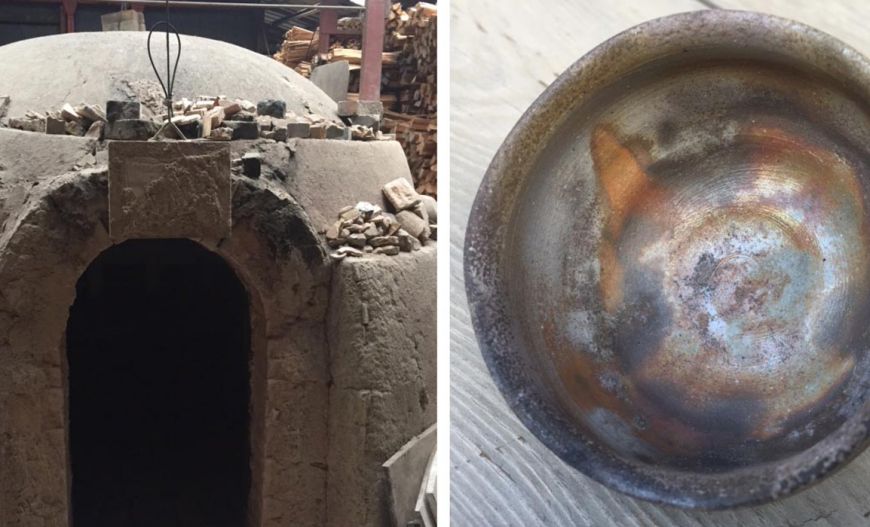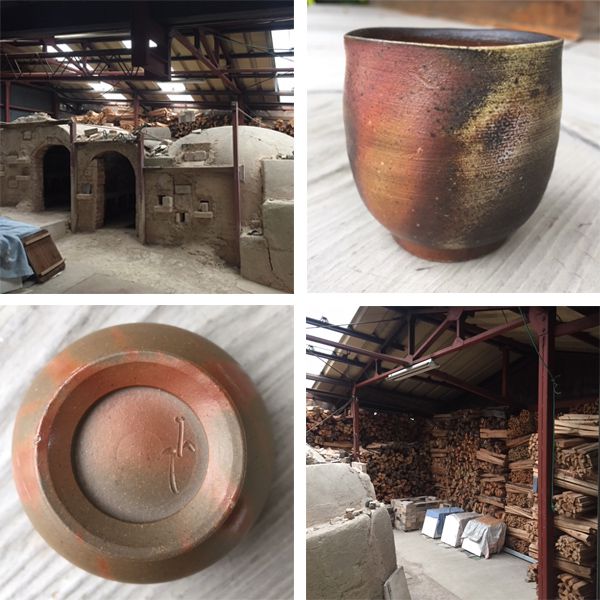10 years, 2 weeks and 10 days to make one teacup
- Holly Helt

I’m sure you would agree that a drink tastes better when it’s served in an appropriate cup or glass. Would you even think of drinking Dom Perignon from a plastic cup?!
Japanese tea in particular seems to come alive with taste and depth of character when it nestles up to Mother Earth in the form of clay that has been moulded by hand and fired in a kiln – and the Japanese have almost made pottery a religion.
Like their cuisine, a sushi chef doesn’t cook ramen, nor does a potter from Bizen craft a white pot with glaze. Bizen pottery is unique and not a single piece is the same nor can it ever be. Once you know how it is made, chances are that you too will join the vast number of devout worshippers.
Bizen is the oldest of the “Six Famous Kiln Towns” in Japan. It’s located on Honshu in the Okayama Prefecture. The other five famous areas are Tokoname, Tanba, Echizen, Shigaraki, and Seto. You will also hear about places like Arita, Mino, Hagi, Mashiko and others but they are not the famous “Six”.
Bizen pottery evolved from the ancient unglazed earthenware called Sueyaki and the same techniques have been preserved generation to generation, continuing without a break for over 1000 years.
The key word here is unglazed. It’s almost hard to imagine that a coating of some kind isn’t applied prior to the piece being put into to the kiln. The mysterious power of fire and clay work together to create these incredible pieces of art that are as utilitarian as they are beautiful. By the time you get to the end of this article, you will understand why the pieces are so revered!
Now the fun part…let’s go through the entire process!!
The clay comes from the Bizen area and is dug up from two meters below the rice fields in wintertime. Fresh clay is susceptible to cracking during the firing process so once it’s dug up, it has to mature for several years, with a maximum of 10 years, before being used to make pottery. After the clay has matured, it’s then pounded, dried, “washed” a few times, leached and then the good stuff is reserved for later use, and stored.
The longer the clay is stored, the better it is for making pottery. It’s cut into seat cushion-sized pieces and kneaded rigorously by hand or foot. The clay is then cut into smaller pieces, stones removed, and formed into a chrysanthemum shape. Finally, after long last, it’s now ready to form and fire!
Most of the ceramists fire in a “climbing kiln” (as in up a hill) that uses red pine for the firing process. Around 4000 pieces of firewood help maintain a temperature between 1200 – 1300 degrees. Next, during the reduction process, about 150 bags of charcoal are used and it’s here where embers fall onto the wares and a chemical reaction takes place between the iron in the clay and the carbon from the embers. When the firing is finished, the kiln is cooled down for 10 days and the pieces are removed.
The remarkable beauty that Bizen pottery is famous for comes from the firing process where natural ash and heat transform and adhere to the clay. The artists don’t know what the pieces will look like until they are removed from the kiln. Bizen pottery is so distinctive in color compared to other unglazed pottery like Tokoname for instance.
The pottery has 5 color classifications:
San-giri: (gunmetal grey, dark gray, blue, white). This is caused by the aforementioned reaction between iron in the clay and carbon in the embers.
Goma: (brown with black specs) This is caused by red pine ash sticking to the clay and melting
Hidasuki: (sienna, brown and red) This is caused by rice straw that has been pounded until soft and wrapped onto the piece before being placed into a saggar (special clay box) and put in the kiln. Here the alkali in the rice straw has a reaction with the iron in the clay. The final appearance resembles the flames in the kiln.
Ao-Bizen: (“Bizen” blue, either light or dark) This is similar in process to Hidasuki above but in the final stages, charcoal is placed on top of the saggar, completely covering it. The charcoal consumes the oxygen in the kiln and this is what turns it blue as opposed to red in Hidasuki. It’s challenging to get this blue hue and is a trophy for the connoisseur.
Hai Kaburi: while not so much a color, this is known for the dynamic appearance that develops. This is the most rare of all Bizen ware. It is only from pieces placed at the fire mouth and from being struck by firewood and buried in embers. The ash melts and creates striking marks but this melting ash often causes the pieces to stick to the kiln so only a very few are in perfect condition.
Now you know the process and how the colors came to be, but the real magic happens when you use it! The colors and gloss deepen just like leather does when used over the years through making contact with the oils from your hands. The taste of your beverage, however, you will notice right away!
Through the unglazed surface, the iron in the clay makes water and spirits taste at their finest, flowers in a vase stay fresher, and bubbles in your beer last longer. I picked up a few “Bizen Balls” to put in my water bottle to give it that sweeeeet “Bizen taste”…but I’ll be drinking my tea from a Bizen cup, that’s for sure…
On my last drive-by, I scooped up 8 incredible cups, made by three Bizen master potters, and they are available in the shop. First come, first served as they say!


About Holly Helt
Holly is American and grew up in Japan drinking Japanese tea from age-three. She has studied two methods of tea ceremony, Urasenke and the lesser-known Yabunouchi, which has a direct lineage to Sen-no Rikyu (known as the father of the tea ceremony) ; it's also the school of practice for samurai. In 2012 she founded Chiki Tea - an online retailer of Japanese green teas, all sourced directly from small farms in Japan. Splitting her time between Japan and her home in Texas, Holly strives to bring the best teas from Japan to as many people as she can find to share in her life's passion.
